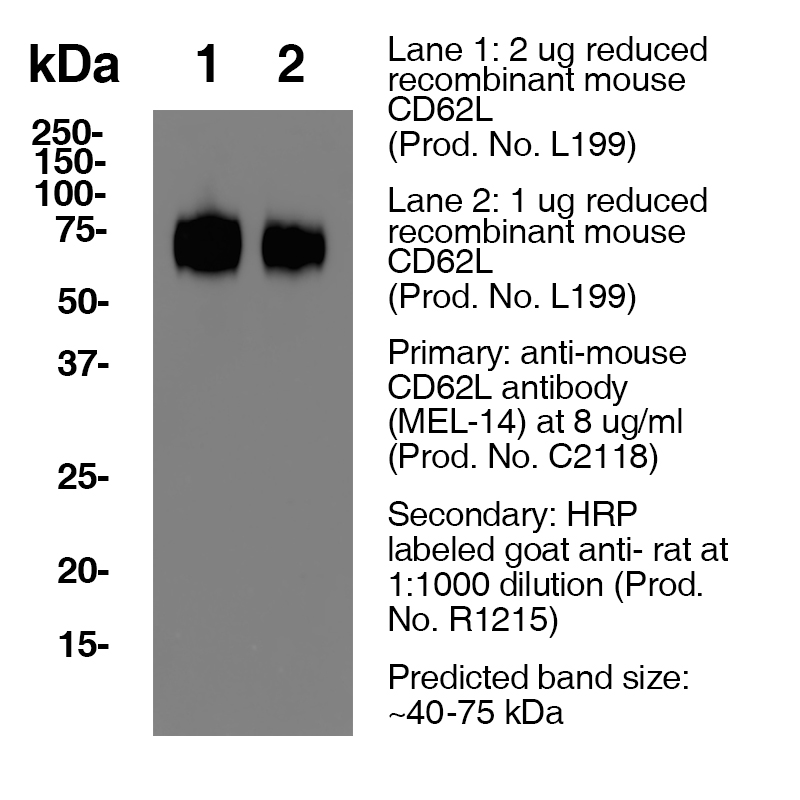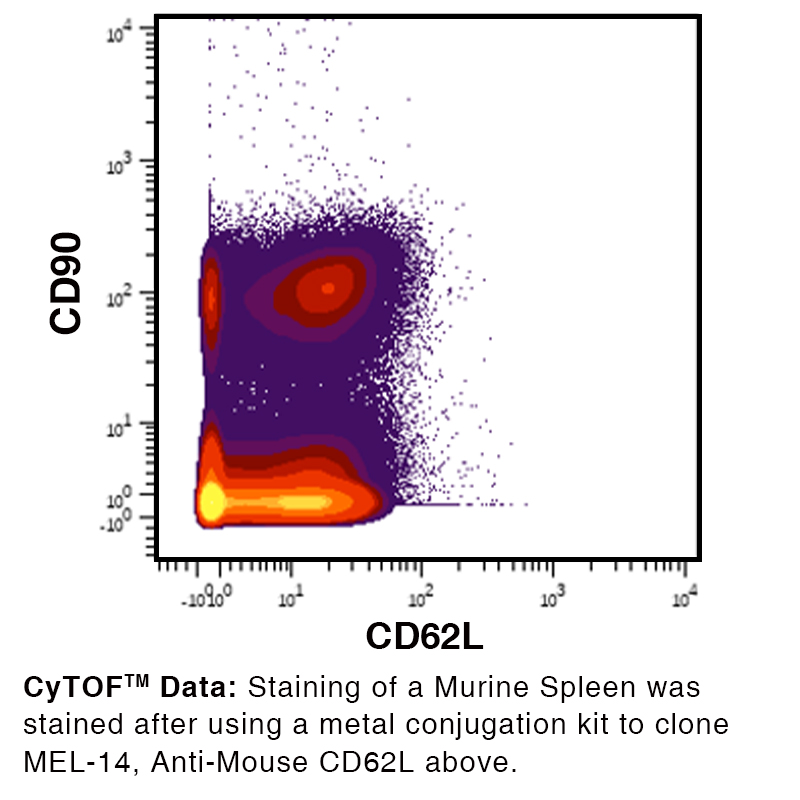Anti-Mouse CD62L [Clone MEL-14] — Purified in vivo PLATINUM™ Functional Grade
Anti-Mouse CD62L [Clone MEL-14] — Purified in vivo PLATINUM™ Functional Grade
Product No.: C6118
Clone MEL-14 Target CD62L Formats AvailableView All Product Type Monoclonal Antibody Alternate Names L-selectin, LECAM-1, Ly-22, LAM-1, MEL-14 Isotype Rat IgG2a κ Applications B , CyTOF® , Depletion , FA , FC , IHC FF , in vivo , IP , WB |
Data
Antibody DetailsProduct DetailsReactive Species Mouse Host Species Rat Recommended Isotype Controls Recommended Isotype Controls Recommended Dilution Buffer Immunogen C3H/eb mouse B lymphoma 38C-13 Product Concentration ≥ 5.0 mg/ml Endotoxin Level <0.5 EU/mg as determined by the LAL method Purity ≥98% monomer by analytical SEC ⋅ >95% by SDS Page Formulation This monoclonal antibody is aseptically packaged and formulated in 0.01 M phosphate buffered saline (150 mM NaCl) PBS pH 7.2 - 7.4 with no carrier protein, potassium, calcium or preservatives added. Due to inherent biochemical properties of antibodies, certain products may be prone to precipitation over time. Precipitation may be removed by aseptic centrifugation and/or filtration. Product Preparation Functional grade preclinical antibodies are manufactured in an animal free facility using in vitro cell culture techniques and are purified by a multi-step process including the use of protein A or G to assure extremely low levels of endotoxins, leachable protein A or aggregates. Pathogen Testing To protect mouse colonies from infection by pathogens and to assure that experimental preclinical data is not affected by such pathogens, all of Leinco’s Purified Functional PLATINUM™ antibodies are tested and guaranteed to be negative for all pathogens in the IDEXX IMPACT I Mouse Profile. Storage and Handling Functional grade preclinical antibodies may be stored sterile as received at 2-8°C for up to one month. For longer term storage, aseptically aliquot in working volumes without diluting and store at ≤ -70°C. Avoid Repeated Freeze Thaw Cycles. Country of Origin USA Shipping Next Day 2-8°C RRIDAB_2829778 Applications and Recommended Usage? Quality Tested by Leinco FC The suggested concentration for this MEL-14 antibody for staining cells in flow cytometry is ≤ 0.25 μg per 106 cells in a volume of 100 μl. Titration of the reagent is recommended for optimal performance for each application. WB The suggested concentration for this MEL-14 antibody for use in western blotting is 1-10 μg/ml. Additional Applications Reported In Literature ? CyTOF® IHC FF IP B Additional Reported Applications For Relevant Conjugates ? IHC (Paraffin) For specific conjugates of this clone, review literature for suggested application details. Each investigator should determine their own optimal working dilution for specific applications. See directions on lot specific datasheets, as information may periodically change. DescriptionDescriptionSpecificity Rat Anti-Mouse CD62L (Clone MEL-14) recognizes an epitope on Mouse CD62L. This monoclonal antibody was purified using multi-step affinity chromatography methods such as Protein A or G depending on the species and isotype. Background CD62L is a 74-95 kD glycoprotein is a member of the selectin family and is expressed on the majority of B and naïve T cells, a subset of memory T cells, monocytes, granulocytes, most thymocytes, and a subset of NK cells. Furthermore, CD62L is a cell adhesion molecule that binds to many glycoprotein ligands including CD34, GlyCAM-1, and PSGL-1. Clone MEL-14 is reported as a Nutralization antibody. Antigen Distribution Subsets of B and T cells, monocytes, granulocytes, subset of NK cells Ligand/Receptor CD34, GlyCAM-1, MAdCAM-1 Function Lymphocyte homing to HEV, rolling on activated endothelium PubMed NCBI Gene Bank ID UniProt.org Research Area Cell Adhesion . Cell Biology . Costimulatory Molecules . Immunology . Innate Immunity Leinco Antibody AdvisorPowered by AI: AI is experimental and still learning how to provide the best assistance. It may occasionally generate incorrect or incomplete responses. Please do not rely solely on its recommendations when making purchasing decisions or designing experiments. Clone MEL-14, a rat monoclonal antibody targeting mouse CD62L (L-selectin), is widely used in various in vivo applications involving mice. These applications include:
Overall, MEL-14 is a versatile tool for studying lymphocyte homing, immune cell migration, and the role of selectins in immune responses within mouse models. MEL-14, a rat monoclonal antibody against mouse CD62L (L-selectin), is frequently used alongside several other antibodies and proteins in immunological research. These companion markers help researchers comprehensively characterize immune cell populations and their functional states. T and B Cell MarkersCD3 serves as a pan-T cell marker and is commonly used with MEL-14 to identify and analyze T cell populations. Since CD62L expression varies between naïve and memory T cells, combining CD3 with MEL-14 helps distinguish these subsets more precisely. The MEL-14 antibody is particularly useful when used together with antibodies to other cell surface markers to distinguish naïve, memory, and effector T cells. Adhesion Molecules and Trafficking MarkersMEL-14 is frequently studied in conjunction with other adhesion molecules and trafficking markers. This makes sense given that CD62L itself is an adhesion molecule that mediates lymphocyte rolling on activated endothelium and homing to high endothelial venules (HEV) of peripheral lymphoid tissues. The protein binds to several glycosylated ligands including CD34, glycam-1, and MAdCam-1, which are important for understanding the complete picture of lymphocyte trafficking and adhesion. Functional ContextThe combination of MEL-14 with these various markers enables researchers to perform comprehensive analyses of immune cell subsets, activation states, and migration patterns. This multi-marker approach is essential in flow cytometry, immunohistochemistry, and functional blocking studies where understanding both cell identity and adhesion properties is crucial. Key findings from scientific literature citing clone MEL-14 highlight its pivotal role in immunology as a monoclonal antibody specific for mouse L-selectin (CD62L), providing important insights into lymphocyte trafficking, cell adhesion mechanisms, and immune cell migration. Essential findings include:
In summary, MEL-14 citations have been foundational in demonstrating the importance of L-selectin in leukocyte homing, delineating the structural-functional relationship of its binding domains, and providing a key antibody tool for dissecting immune cell migration in vivo and in vitro. The search results provided do not contain comprehensive information about how dosing regimens of clone MEL-14 vary across different mouse models. While several sources mention the MEL-14 antibody and its applications, specific dosing regimens across different mouse models are not detailed in the available search results. Available Dosing InformationThe search results primarily provide general usage guidelines rather than specific dosing regimens for different mouse models. For flow cytometry applications, the suggested concentration is ≤ 0.25 μg per 10⁶ cells in a volume of 100 μl. For western blotting, the recommended concentration is 1-10 μg/ml. Functional ApplicationsThe MEL-14 antibody has been documented in various functional studies. It has been shown to completely and specifically block binding of lymphocytes to high endothelial venules (HEV) in vitro and inhibit lymphocyte migration to lymph nodes in vivo. In delayed-type hypersensitivity (DTH) models, MEL-14 administration reduced ear swelling by blocking naive T cell recruitment to inflammation sites. Research ConsiderationsThe search results emphasize that titration of the reagent is recommended for optimal performance for each application, suggesting that dosing may need to be optimized based on the specific experimental context. One source mentions that each investigator should determine their own optimal working dilution for specific applications. Without access to detailed protocols from published studies using MEL-14 across various mouse models (such as tumor models, inflammatory models, or different genetic backgrounds), a comprehensive comparison of dosing regimens cannot be provided based on the available information. References & CitationsTechnical ProtocolsCertificate of Analysis |
Related Products
Prod No. | Description |
|---|---|
S211 | |
R1364 | |
I-1177 | |
C247 | |
F1175 | |
R1214 | |
S571 |
Formats Available
Prod No. | Description |
|---|---|
C2103 | |
C2091 | |
C2092 | |
C2094 | |
C2089 | |
C2095 | |
C2096 | |
C2097 | |
C2099 | |
C2100 | |
C2101 | |
C2093 | |
C2118 | |
C6118 |
 Products are for research use only. Not for use in diagnostic or therapeutic procedures.
Products are for research use only. Not for use in diagnostic or therapeutic procedures.




